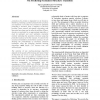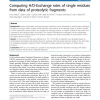27 search results - page 3 / 6 » Impact of residue accessible surface area on the prediction ... |
IJBRA
2007
13 years 5 months ago
2007
A function of a protein is dependent on its structure; therefore, predicting a protein structure from an amino acid sequence is an active area of research. Optimally predicting a ...
BMCBI
2008
13 years 5 months ago
2008
Background: Prediction of protein solvent accessibility, also called accessible surface area (ASA) prediction, is an important step for tertiary structure prediction directly from...
NAR
2006
13 years 5 months ago
2006
ACT dbPTM is a database that compiles information on protein post-translational modifications (PTMs), such as the catalytic sites, solvent accessibility of amino acid residues, pro...
BMCBI
2010
13 years 5 months ago
2010
Background: Protein conformation and protein/protein interaction can be elucidated by solution-phase Hydrogen/ Deuterium exchange (sHDX) coupled to high-resolution mass analysis o...
BMCBI
2010
13 years 5 months ago
2010
Background: Many biological functions involve various protein-protein interactions (PPIs). Elucidating such interactions is crucial for understanding general principles of cellula...



